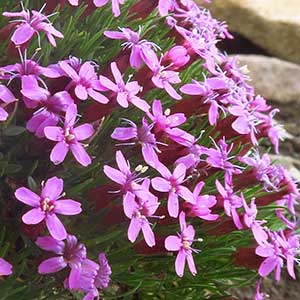Silene acaulis
Silene bridgesii
moss campion, silène acaule
Bridges' campion, Bridges' catchfly
erect, leafy proximally, 3–6(–15) cm, old leaves persistent at base.
erect, with 3–6 pairs of leaves below inflorescence, 30–80 cm, short-pubescent, glandular and somewhat viscid distally.
mostly basal, densely crowded and imbricate, sessile;
blade 1(–3)-veined, linear-subulate to lanceolate, 0.4–1(–1.5) cm × 0.8–1.5(–2) mm, margins cartilaginous, often ciliolate especially proximally, apex acute, glabrous to scabrous.
proximal petiolate, blade oblanceolate, 3–6(–8) cm × 5–15 mm (including petiole), base tapered into short petiole, apex acute to obtuse and apiculate, short-pubescent on both surfaces, pubescence rather sparse adaxially;
cauline leaves sessile, blade elliptic-lanceolate, 2–6 cm × 5–15 mm.
solitary flowers.
branched, several–many-flowered, open, bracteate, flowering portion to 15 cm and ca. 1/2 as broad, glandular and viscid;
cymules usually 1–3-flowered;
bracts narrowly lanceolate, shorter than pedicel;
peduncle shorter than internodes.
2–40 mm.
divaricate, sharply bent distally, 5–15 mm.
bisexual or unisexual, all plants having both staminate and pistillate flowers, others having only pistillate flowers, subsessile or borne singly on peduncle;
calyx 10-veined, lateral veins absent, tubular to campanulate, (5–)7–10 mm, herbaceous, margins often purple tinged, dentate, sometimes ciliate, ± scarious, glabrous, lobes lanceolate to ovate, 1–2 mm;
petals bright pink, rarely white, limb unlobed to shallowly 2-fid, 2.5–3.5 mm, base tapered into claw, auricles and appendages poorly developed;
stamens exserted in staminate flowers, not so or aborted in pistillate flowers;
styles 3.
nodding;
calyx prominently 10-veined, tubular to campanulate, umbilicate but narrowed at base, lobed, 9–11 × 3–5 mm in flower, in fruit ovate to turbinate, 5–8 mm broad, viscid-pubescent, veins parallel, green, papery between;
lobes 5, narrowly lanceolate, obtuse, 2–3 mm, ciliate;
corolla ± white, often greenish abaxially and pink tinged, 2 times calyx;
petals 2-lobed, margins entire to erose, appendages linear, narrow, 1–2.5 mm;
stamens often long-exserted;
filaments pubescent at base;
styles persistent, 3, long-exserted, filamentous, exceeding 2 times calyx.
3-locular, cylindric, equaling or to 2 times calyx, opening by 6 recurved teeth;
carpophore ca. 1 mm.
broadly ovoid, ca. equaling calyx, opening by 6 ascending, triangular teeth;
carpophore 2–3 mm.
light brown, reniform, 0.8–1(–1.2) mm broad, dull, shallowly rugose.
reddish brown, reniform, 1.2–1.8 mm broad, coarsely papillate.
= 24.
= 48.
Silene acaulis
Silene bridgesii
Silene acaulis is a variable species, and most workers have recognized infraspecific taxa in North America: subsp. acaulis (subsp. exscapa and subsp. arctica), which is predominantly arctic; and subsp. subacaulescens, which extends down the Rocky Mountains from Alaska to Arizona and New Mexico. In subsp. acaulis, the leaves are flat and short and the flowers are subsessile and smaller in size. Subspecies subacaulescens is typically a larger, less-compact plant with longer, narrower leaves and larger, pedunculate flowers. However, in many populations, these two variants are poorly differentiated, and in others both occur together, connected by intermediates.
Silene acaulis is widely distributed in arctic and alpine Europe.
(Discussion copyrighted by Flora of North America; reprinted with permission.)
Silene bridgesii is similar to S. lemmonii but usually can be distinguished by its larger size, broader and larger leaves, the near-absence of sterile basal shoots, and larger floral parts and fruits. Although S. longistylis has often been cited as a synonym of S. lemmonii, examination of the holotype (Henderson s.n., GH) indicates that it is referable to S. bridgesii.
Silene bridgesii is found in the Sierra Nevada and southern Cascades.
(Discussion copyrighted by Flora of North America; reprinted with permission.)


